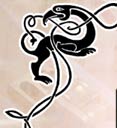A wire cross-strung chromatic harp played concerts of J.S.Bach
and Richard Wagner music.
It was called the "Lute-harp"; it was designed by Gustave Lyon
around 1899 and built by Pleyel as a "special" instrument. It
retained most of the characteristics of the "Harpe Chromatique",
that is the cross-stringing configuration and the absence of
mechanical devices such as pedals, hooks or levers. Its
soundboard was however modified (hardwood). For some reason, Pleyel gave it
a twin column, although this instrument was also built with one
single column (Roslyn Rensch makes reference (in "Harps and
Harpists") to a picture of Johannes Snoer, harpist in Leipzig,
holding a small straight column wire cross-strung harp set on a
legged stand). These instruments were built much smaller than
the other Pleyel "harpes Chromatiques" and featured up to 5 octaves.
The main characteristic of the Lute-harp was that it was strung
with wire (steel) and that this feature according to its designer
was meant to provide an alternative to other string instruments such as the
harpsichord and the spinet. Gustave Lyon's idea was that the
Lute-harp would be a desirable instrument to play the harpsichord's
large musical r pertoire; work such as that of Rameau, Daquin,
Scarlatti, H ndle, Bach, etc. The Lute-harp would allow a more
subtle interpretation of this music, and in fact, would give a
complete new life to this music. In "La harpe chromatique et sa
facture" , Paris 1927, and in "La Revue Musicale", 1907, (p.
360-362).
Gustave Lyon wrote that J.S Bach's unhappiness with the
harpsichord was caused by the frail and dry sound of this instrument. Lyon
suggested that a wire strung instrument on which the strings
would be plucked from the pad (not the nail) of the finger would
provide a more melodious sound. According to Lyon's communication in "La Revue
Musicale", the first lute-harp built by pleyel was handed out to
a famous harpist called Miss Ren e L nard , who was already playing
the gut strung chromatic harp and she performed publicly four
days later. The instrument was received warmly by a prestigious
audience. One of these Lute-harps was built at the request of
Richard Wagner to accompany Beckmesser's serenade in "Die
Meister-Singer". According to R. Rensch (op.cit. p 138) harpists in this
opera orchestra often threaded paper or cloth strips through the
harp strings in an attempt to achieve the desired "cracked lute
effect". According to the correspondence addressed in 1899 by
Cosina Wagner to Gustave Lyon,
gave complete satisfaction in performances, in
Bayreuth, Paris, Mannheim, Amsterdam, The Hague, Venise and
Milan.
On other stages, the lute-harp took part in several major concert
performances, featuring, among others, the music of J.S. Bach.







